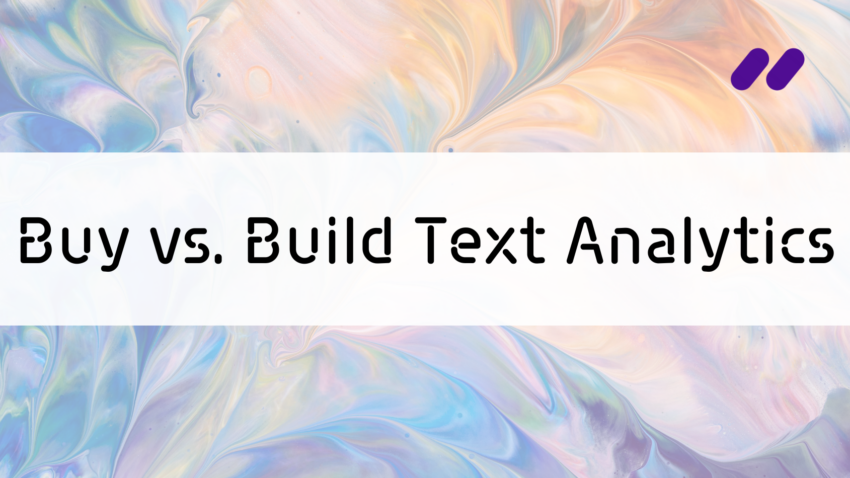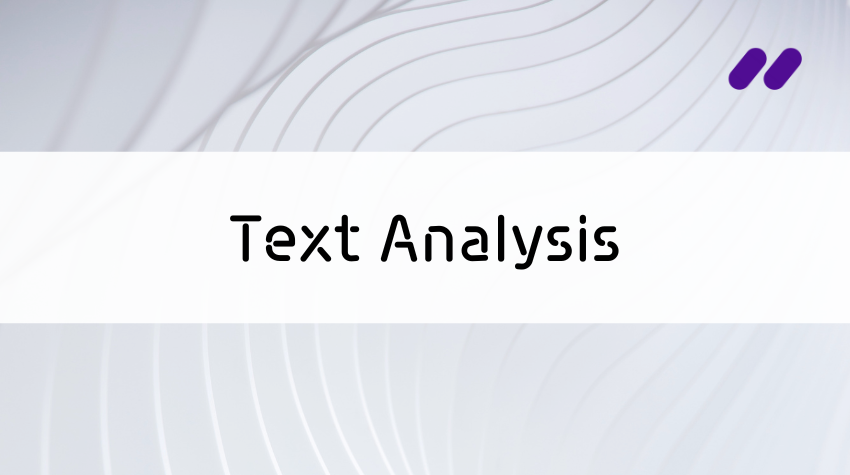We so feel your pain. What started as you trying to answer a simple question and gain insight from your data turned into weeks spent working across teams and departments to untangle the web of complicated hurdles that stand in your way. Perhaps you thought you’d find clear answers when you set out to see what feedback you’d received after the launch of that new nail colour, or why so many people were abandoning their carts before completing their order, or how many more people were being drawn into your brick and mortar store since you’d changed your visual display. So you turned to your marketing team, your sales crew, your social media experts, your customer support staff and your inventory systems to look for clues, and instead found a knotted maze of siloed data, misaligned tools and processes, poorly communicated test results and under-utilized pools of rich, unstructured feedback no one seemed to leverage or understand.
So you did your research, weighed your options and found a tool you’re convinced could streamline and improve every level of decision-making in the company: text analytics. You confidently walked into your boss’s office excited to share your new solution and get the ball rolling … and nothing. Perhaps some tepid curiosity, a passive nod to your hard work and a promise to look into it as soon as the company is truly ready to make the big, intimidating shift towards AI and sentiment analysis.
You’re not alone. Despite predictions that the text analytics market will grow to become a $10.38 billion industry by 2023 and research by the likes of McKinsey showing that data-centric companies can improve their marketing ROI by 15%-20%, forward-thinking marketers, product managers and customer experience experts are still struggling to get management and decision-makers on board. In fact, a Forrester study found that 49% of data professionals surveyed felt that their C-level executives didn’t fully support their data and analytics strategies. So how can you build your case and secure that upper-level buy-in in order to reap the benefits of sentiment analysis and data analytics across your whole organization? Here are a few tips to help you land your pitch.
Speak to their pain
If you’ve had your nose to the grindstone for weeks, it can be hard to remember that other key stakeholders might just be scratching the surface of this whole text analytics thing. So before stepping into their office, try to take a step back from your own objectives to figure out what’s driving and blocking the people you need to convince. You might be trying to get the pulse on the social media chatter surrounding your new product, but your CFO is probably trying to figure out how to maximize inventory and cut costs. You may want to know if your new in-app purchasing process is boosting conversions, but your COO is likely trying to decide what kind of developers to hire. Once you’ve identified their pain point, try to find the blind spot in their data insights that might be stopping them from making effective, clear-eyed decisions.
The really interesting insights come when you marry text analytics with quantitative data, operational data, financial data.” – Thomas Kunjappu, Senior Product Manager. Twitter.
What if your CFO could seamlessly analyze thousands of reviews, social media posts and customer support interactions to extract feedback, trends and complaints from customers disappointed they couldn’t find their favourite item in stock? What if your COO could analyze thousands of qualitative data points to find out that customers felt nervous about your company’s ability to keep their digital information secure? Armed with those insights and analytical capabilities, they may want to shift their production focus or hire a security software developer. You get a data-backed communication and marketing strategy, they get a more effective tool for decision making and implementation, and your clients get to feel secure and confident buying that one shade of lipstick they’ve come to love.
Carefully manage expectations
One of the surefire ways of soliciting dubious looks and weary hesitations is to try selling your customer feedback solution as the ultimate silver bullet to each and every one of the company’s problems. Though it’s a powerful tool, sentiment analysis is just that: a tool. And like any other tool, its effectiveness needs to be backed up by tangible, quantifiable proof. That’s why we suggest finding ways to first validate your new solution by applying it to small, well-defined experiments that don’t require top-level buy-in to hit the ground running.
Organizations looking to take a data-centric approach shouldn’t boil the ocean, and focus on delivering value. They should start with a concrete use-case that’s high ease and value, i.e. the low-hanging fruit, to actually experience delivery of a data-centric project, then build on its success by capitalizing on the buy-in and skills built from the experience.’” – Aki Matsushima, Lead Data Scientist, Direct Line.
You might, for example, counter negative online reviews and social media comments about the frustrating complexity of your customer service by experimenting with a lower threshold for support staff to hand files over to managers. As customers spend less time trying to move up the decision-making ladder and feel taken seriously by your company, your sentiment analysis insights and NPS score are likely to reflect that shift within days or even hours – giving you a convincing and tangible use case for text analytics at their best. Also consider digging around to pull back the curtain and find examples of trailblazing organizations that have given themselves a competitive edge by leveraging the latest in sentiment analysis. Check out our case studies and resources like these for inspiration from the likes of Visa, NASA, BPN and more.
Sell them on speed
Market research and analysis in the retail space have long had a reputation for being clunky, expensive and lengthy. But with a robust customer feedback solution, the data once collected in those lengthy surveys and labour-intensive focus groups can be collected in days, if not hours. And while we do our best to avoid tired clichés, time is money – and money is a powerful way to motivate your executive ranks and speed up the buy-in process. It’s no secret: online reviews, social media chatter, customer support calls and digital chatbots offer invaluable qualitative information about how your customers feel about your brand, products and services, but that information can only be turned into insight once you have the horsepower you need to quickly compare and contrast all of those unstructured data sources to identify connections and trends.
Here’s an example: you’ve launched a new skincare product and are manually perusing online for initial impressions and feedback. A couple of online reviews saying your new moisturizer leaves skin feeling greasy may just point to a few customers choosing the wrong product for their skin. But watching a real-time uptick in words like oily, gross, dirty, shiny or sticky being used in close proximity to your brand name across multiple social media channels and review sites is a whole other thing. In the past, that level of trend-spotting and cross-channel visibility would have taken weeks, but with the computational power of text analytics and sentiment analysis, your team can see it emerge in mere minutes. With that kind of speed, your team can not only get ahead of the problem by slowing down promotional efforts and perhaps shifting messaging towards use for people with extremely dry skin, but can then track the impact of your damage control efforts in real-time to make sure you’re effectively realigning with customer expectations. That kind of responsiveness and accelerated decision-making is bound to pique the interest and curiosity of any leadership team.
Sell them on effective collaboration
Despite the incredible proliferation of internal communication and project management tools now available for teams big and small, most organizations still find effective collaboration and cross-departmental decision-making to be one of their biggest challenges. An Econsultancy study, for example, found that 40% of customer experience teams felt they weren’t supported by their organizations because different departments had their own agendas. But beyond differing goals or internal power struggles, another big challenge stands in the way of getting everyone on the same page: data silos. While your marketing team may be looking at its social media analytics, your sales team is looking at its growth metrics, your customer support team is looking at its complaints stats and your executive team is looking at its bottom line. With that kind of funnel vision, it becomes incredibly difficult to spot opportunities and patterns across those different data sources, types and formats – let alone reach a consensus about what to do next.
Historically, retailers turned to internal employees, marketing agencies or research firms to gather data, using trained personnel to conduct opinion surveys, store visits or mystery shops. These methods, however, often took too long to generate meaningful results, or could not be run frequently enough without introducing bias, and were expensive. – Çağlar Bozkurt, Cofounder & CMO, Twentify
In her exploration of the hidden cost of data silos, Data Iku’s Pauline Brown highlights three major risks for lost time, money and resources.
- Lost time: time spent tracking down data isn’t being spent on developing actual business-impacting initiatives.
- Incomplete data projects: not knowing what data is available can mean making key decisions based on limited information and context.
- Incorrect models: having limited understanding or access to data can lead to teams making flawed assumptions and misguided business decisions.
With the right text analytics solution, it’s much easier to spot a correlation between a drop in sales, and a wave of discontentment being shared and spread across your social media channels. With full qualitative visibility across all unstructured feedback channels, you’re much likelier to connect the dots between your flawed customer support structure and your increase in refund requests. And if your decision-makers are all objectively looking at the same un-siloed pool of data to get a problem solved, they’re much more likely to draw similarly unbiased, evidence-based conclusions about what to do next.
Curious to know more about how an AI-powered customer feedback solution like Keatext can help you improve efficiency, responsiveness and decision-making across your retail organization?


